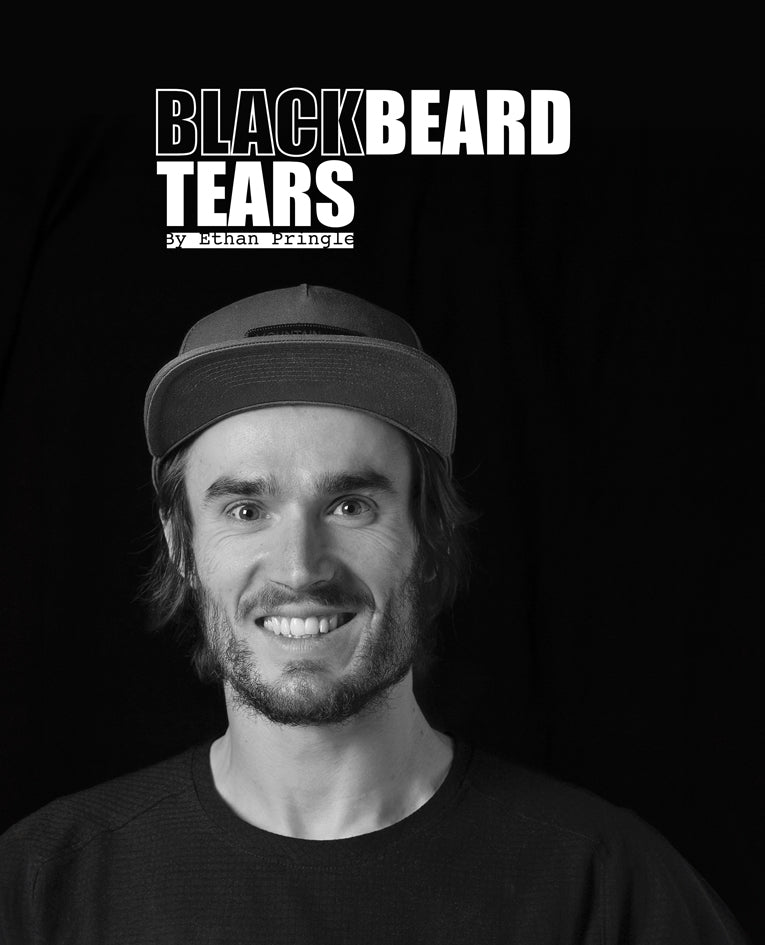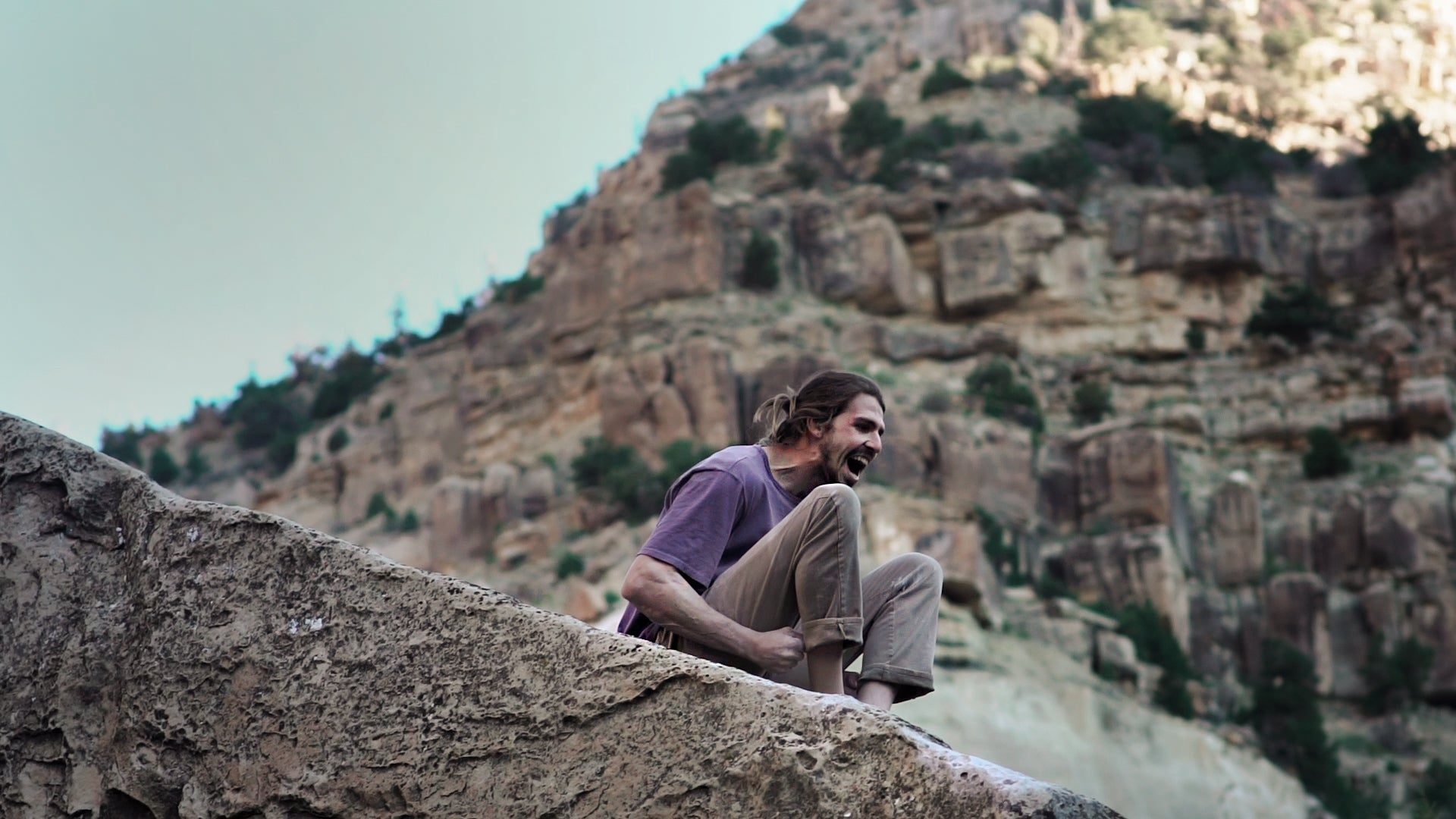
Ethan Pringle | Blackbeard Tears
In the autumn of 2015, Jim Thornburg and Steven Roth told me about a hard crack line after returning from a trip to The Promontory— one of Northern California’s best-kept secret crags. The line sounded like a fantasy: more than one hundred feet of steep, thin, splitter crack snaking through a bullet-hard, water-streaked swath of sandstone that loomed over the Pacific Ocean. The route, “Blackbeard’s Tears,” had only been aided years earlier but not yet free climbed. It took up residence in my mind.
The following summer I planned a trip to the Promontory to check out Blackbeard’s. In the weeks before my departure I frantically texted Steven who had tried the line a tiny bit the year before, hanging on his every word like a gossip-hungry teen:
Me: Dude, I’m planning on checking out that crack at The Promontory! What do you think? Will it go free? Is it cool? I’m all psyched!
Steven: Yep, it’ll go free for sure. I did all the moves up to the last 30 feet. The climb will be mega. Like really classic. And the gear is bomber.
Me: Dude, YES! Best news I’ve heard all month! I’m sofa king psyched!!! You said you did all the moves up to the last 30 feet…what’s after that?
Steven: An awesome looking headwall! Looks like it might be pretty run out but you’re high off the deck at that point. The roof section is hard and that’s before the headwall so it’ll be a toughie!
I was buzzing.

The scrappy crags along Northern California’s coastline where some of the first places I climbed outside. I remember getting lost trying to find the Scott Frye classic “Endless Bummer” with my dad at 11 years old. We eventually located the rock but I was too intimidated to go for it. The committing moves were hundreds of feet above the ocean and felt gut-wrenchingly exposed. The 5.12’s and 5.13‘s on the Mickey’s Beach main rock were some of my first red points of the grade, and for a local bay area crag, they’re actually really good. The thing about the rocks along the coast of California is that the further north you go, the bigger, cleaner and steeper they get. I always had a feeling the north coast would deliver some difficult project of biblical proportions. Would this crack at The Promontory be it?

I finally left for the Promontory on September 1st, 2016. As I drove up HWY 101 towards Humboldt and Del Norte Counties, the hills became steeper, greener and denser with tall redwoods and sequoias that slowly replaced the oak and vineyards of Sonoma and Mendocino. Driving this stretch of highway brought back memories from my first climbing trip way back in 2004 to check out Lost Rocks, the now famous bouldering area just ten miles south of The Promontory. For years I’d heard stories of this idyllic place with jutting overhangs of Greywacke sandstone on a long, magical beach. The place envelops you as soon as you step out of the car: the light touch of the sea breeze, the bark of seals playing and hunting at the mouth of the Klamath River, the constant and irregular crashing of waves against the silence of the mist in the redwood forest above the beach. The rock is smooth and there are some classic boulder problems with very few other people around. Every few years I returned to Lost Rocks for a bit of “souldering” (soul bouldering).
Finally, I arrived. I met Jim in the parking lot and we walked along the boulder-strewn beach to the cliff. First to hit the floor was my backpack and after looking up at Blackbeard’s, it was my jaw. We stood below the crack that split the exact center of the massive concave overhang.It was steeper, cleaner and more inspiring than I could have imagined and more intimidating.
I lowered down the line, looking for beta and gear placements. Local strongman Nic Sabo had nearly climbed the line up to the roof and speculated it to be 5.13+ on its own. I wanted to take the line to the top of the wall and I knew pulling the roof would be the hardest section.
I hang-dogged my way up the route and arrived at the roof. This was the moment of truth. I hung there, panicked that the sequence would be stupidly hard or impossible. There we so few holds, and they were bad! Luckily, I found a perfectly located crimp to the left of the crack in the face. My hope renewed, I started trying the moves. Soon I knew it would go, and then felt the rush of excitement and anxiety about what it would take to make it happen. I was obsessed.
Every morning I woke up burning to get back to the crack. I linked moves, then sections. Before long I was going for red-point burns from the ground and was able to get to the crux of the roof. I made steady progress, trying two or three times per day, getting more comfortable with the sequences and a move or two higher every time. The two main cruxes of the route are so bouldery that it’s nearly impossible to stop and place protection for sustained 10-15 foot sections, which made for some thrilling run-outs.
On rest days I’d hang out in Arcata and drink coffee, shop at the hippy markets, go to a yoga class, or go surfing. One day I went for a run through the breathtakingly beautiful Jedediah Redwoods near Crescent City before cooling off with a swim in the crystal clear Smith River. The stresses of Bay Area seemed distant. In the safety of the woods, I was able to turn my attention inward something I hadn’t done much of in the previous months. The practice felt healing and invigorating.
On my seventh day of work, I had a breakthrough attempt, falling on the very last move to the clipping jug. It removed any shadow of a doubt that I could climb the route. For me, that realization is always the most exciting part of projecting something really difficult- the point at which the work is done and all that’s left to do is hang on. But that’s also when the pressure to send can start to get in your head.
The steady flow of friends visiting from the bay area that I’d been blessed with during the first half of my trip had dried up and I was left scrambling for partners. Jim was committed to capturing my send with his drone but he had to go home, so I took three consecutive rest days. I putzed around Arcata, sleeping outside the gym in my car. The town and all its citizens-weed growers, business owners, disgruntled hippies (or some combinations of the three), and HSU students all seemed busier than before. I felt aimless and stale. A different kind of pressure started to creep in with thoughts like, “OK, it’s time for me to wrap this up so we can move on.” Familiar partners weren’t the only things to disappear- the gale force winds of late summer that had blessed my sessions with favorable conditions had faded and the temperatures rose, making the holds feel a lot more slippery and the crux a lot harder.
Jim returned from The Bay. We wrangled a few bright eyed and bushy tailed HSU students who we met at the gym to come belay me. They didn’t get out of class until 2 pm and it was dark by seven. I felt a little stressed under the time constraint but there was
nothing we could do.
On the way to the crag, I imagined myself slipping out of the shallow, painful finger-lock at the crux with a bloodied finger, and then the listless rest days in Arcata as it healed.
On days eight and nine I fell randomly throughout the crux and my frustration peaked.
I screamed “fuck” so loud my voice became hoarse. The HSU kids didn’t seem to mind. Having already climbed all but the final move, my unsuccessful attempts earned the dreaded label of “reverse progress,” which compounded my frustration.
It was clear that I had the route dialed but neither the conditions nor my nerves were cooperating. In the beginning, I’d look up at the route and feel inspired, now I felt afraid.
Early afternoon on my tenth day the conditions still sucked. On my first attempt, I fell low in the crux but I no longer had the fight in me to protest my performance. I pulled back on and the crux felt easier than it ever had before, despite the heat. I one-hung the route with authority. Now I knew I could do it even in shitty conditions.
Then the wind picked up for the first time in days. Soon it was howling.
Taking a little walk around the crag I looked up and down the coast and out at the ocean, marveling at its power and enormity. The glaring sunlight shimmered across it’s textured, ever-changing surface.
I reminded myself why I was there, why I’d undertaken this project--not simply to snag the FA of the most inspiring undone line I’d ever seen (though the draw of that was
undeniable), but to put myself in a place of uncertainty where I am forced to relinquish control and accept what life has to offer that day. I was there to surrender.
Back at the base of the route, the mood was different. Few words were spoken. Racking up, taping my fingers, lacing up my shoes, was all so rehearsed it felt like second nature. I reminded myself not to get ahead of myself, while still secretly getting ahead of myself.

Finally, I started up the meat of the route. Behind me, something that sounded like a weed whacker meant Jim had launched his drone.
With the practice often long days behind me I climbed the 13+ section of the route as composed and calmly as I could, taking my time and relaxing on moves that had seemed scary and uncomfortable in the beginning. I gained the rest of the fist-sized pod below the roof, opening my chest away from the wall to take fuller breaths, switching hands as I recovered in the pod.
Leaving the rest below the roof, Jim shouted some words of encouragement from which I drew confidence. I reminded myself how well I knew these moves and relaxed further. I slowed down and paid attention to the nuances of each familiar hold and body position. I stuck the wild jump to the chockstone above the lip, campused out left and executed several more moves to gain the final rest, plugging my last two pieces of gear.
When I felt about as rested as I could get, I shook out a couple more times. I once read a book by Andrew Bishirat that recommended this.
I left the rest, conserving as much strength as I could for the last move. I went for it with all the determination I had left and snagged the finish jug with a guttural yell. I clipped the anchors but I wanted to climb higher, over the dirty lip of the wall and into the bushes on top of the cliff.
Sitting in the bushes on top of the cliff I finally released all the pressure I’d put on myself during the last week of attempts. I knew in that instant I’d been worthy of my own respect the whole time regardless of the outcome of my efforts and starting sobbing uncontrollably. I’d always been me, whether I was hanging from the rope or on top of the crag, in this wonderful place between the biggest body of water and the tallest trees on earth.
And I got poison oak.


3 comments
“to put myself in a place of uncertainty where I am forced to relinquish control and accept what life has to offer that day. I was there to surrender.”
And
“I’d always been me,”
That’s the lesson that climbing teaches us. That’s really profound Good writing. Thanks
Beautifully written. But it’s Andrew Bisharat, not bishirat
Ha! And I got Poison Oak! I have it now! Great send. NC has amazing lines, and possibly the most amazing setting for climbing. I’d like to hop on this!